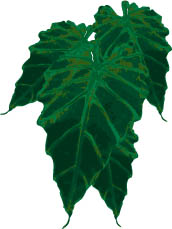Elephant’s Ear
Lush Plants That Give a Tropical Look
These plants look as if they belong in one of Rousseau’s lush paintings, for they have that quintessential tropical look. Their common name equates them with elephants because their large leaves bear some resemblance to those huge flapping ears that made Dumbo famous. In botanical terms, their leaf shape is known as broadly sagittate, meaning like an arrowhead, but elephant’s ear is so much more fun.

Several different genera of plants go by this common name. Alocasia is one of them, and there are two easy-to-find species that can be grown outdoors in our mild climate. A. macrorrhiza and A. odorata look very similar, but they can be identified by their inflorescences. Both produce a spadix covered with tiny white flowers nearly encircled by a green shiny spathe. Both are fragrant, but A. macrorrhiza has a fruity perfume (kind of like Juicy Fruit gum), while A. odorata fills the air with a sweet and heady perfume. While the flower stalk isn’t showy, bring one into the house and it will scent an entire room. In the garden, these fragrances attract many small flying insects that assist in pollination as they feed on pollen. The resulting seeds are enclosed in a bright red flesh so that the inflorescence resembles a short ear of corn with the fruits clustered all around the stalk. Plants grow easily from seed, but also produce pups or side shoots that can be removed and rooted.
The species of Alocasia are a medium green, but there are some hybrids and selections with more colorful foliage. One variety from Thailand called ‘Aurora’ has bright pink stems. A. cuprea ‘Wax Doll’ has metallic copper-colored leaves and A. wentii has leaves that are green on top, but metallic purple underneath. These are available from specialty suppliers such as Stokes Tropicals (stokestropicals.com). All elephant’s ears grow in clumps and some can become quite large with leaves as long as two feet on top of stalks up to five feet in height. There is even a selection called ‘Borneo Giant’ that can have leaves six feet across and 12 feet long.
Next up is Colocasia esculenta. This species is the plant known as taro or dasheen in Hawaii and Polynesia. The large, starchy rhizome is pounded and worked to release the caustic oxalic acid that is common in all of the elephant’s ears, and the resulting paste is the food staple poi. Cooking will also disarm the oxalic acid, and taro roots and stems are eaten in many parts of the world from Asia to the Mediterranean. The large leaves are also used to wrap foods for cooking.
Like Alocasia, there are varieties of taro with different colors of foliage. The color may be in the leaves and/or the stems. ‘Black Magic’ has deep black stems and leaves, while ‘Nancyana’ leaves and stems are bright green except for the bright white central veins of the leaves. ‘Fontanesi’ has deep purple stems, while ‘Violet Stem’ has reddish purple stems.
Another closely related genus is Xanthosoma. It too is used as a food staple in the tropics and has the common name of ape. X. violaceum has robust stems and huge arrowhead-shaped leaves. The entire plant is covered with a heavy wax, giving it a purplish-blue cast; very striking among the other shades of green in a tropical garden. X. sagittifolium eventually produces a stout stem up to three feet in height. Neither is often found at nurseries, but keep your eye on plant society sales and you may find one.
All elephant’s ears do best in shade or partial shade and moist conditions. If you are unwilling to irrigate a large area, they can all be grown in containers. Be sure to take into account their ultimate size when choosing a pot for them. Another planting suggestion is to grow them in a pot submerged in the water garden. Take care to keep them near the surface of the water. If they are too deep, they might eventually rot. Most will take a light frost with the loss of uppermost parts, but should grow again from the base. The warmest situations will produce the largest plants, so find them a sheltered spot. Keep mulched for nutrient cycling and water retention.



